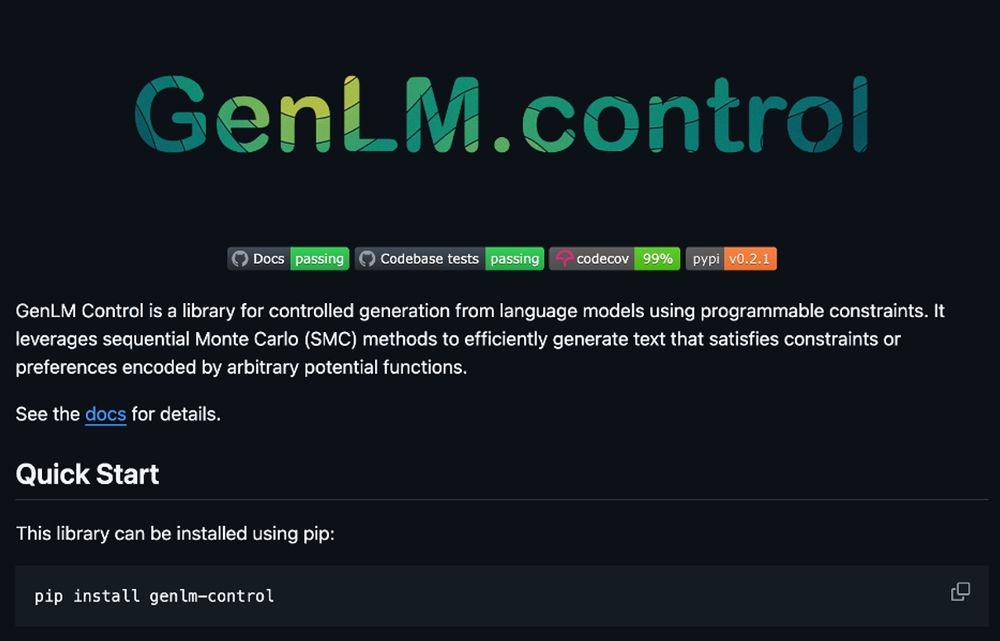
1 - run MCMC / SMC / etc. targeting p(θ|D)
2 - run VI to obtain q(θ) then draw independent θs from q via simple MC
Not obvious that Method 1 always wins (for a given computational budget)
1 - run MCMC / SMC / etc. targeting p(θ|D)
2 - run VI to obtain q(θ) then draw independent θs from q via simple MC
Not obvious that Method 1 always wins (for a given computational budget)
Check out the GenLM control library: github.com/genlm/genlm-...
GenLM supports not only grammars, but arbitrary programmable constraints from type systems to simulators.
If you can write a Python function, you can control your language model!

Check out the GenLM control library: github.com/genlm/genlm-...
GenLM supports not only grammars, but arbitrary programmable constraints from type systems to simulators.
If you can write a Python function, you can control your language model!
Julia: github.com/probcomp/ADE...
Haskell: github.com/probcomp/ade...
The (less pedagogical, more performant) JAX implementation is still under active development, led by McCoy Becker.
Julia: github.com/probcomp/ADE...
Haskell: github.com/probcomp/ade...
The (less pedagogical, more performant) JAX implementation is still under active development, led by McCoy Becker.
- Alexandra Silva has great work on semantics, static analysis, and verification of probabilistic & non-det. progs
- Annabelle McIver does too
- Nada Amin has cool recent papers on PPL semantics
- Alexandra Silva has great work on semantics, static analysis, and verification of probabilistic & non-det. progs
- Annabelle McIver does too
- Nada Amin has cool recent papers on PPL semantics
Curious what people think we should make of this!
8/8

Curious what people think we should make of this!
8/8
This penalty says: try not to lose any of the behaviors present in the pretrained model.
Which is a bit strange as a fine-tuning objective.
7/
This penalty says: try not to lose any of the behaviors present in the pretrained model.
Which is a bit strange as a fine-tuning objective.
7/
Now, the objective has a CrossEnt(pi_ref, pi_theta) term. KL(P,Q) = CrossEnt(P,Q) - Entropy(P), so this is related to KL, but note the direction of KL is reversed.
6/
![**Mathematical formulation of an alternative KL estimator and its gradient.**
The alternative KL estimator is defined as:
\[
\widehat{KL}_\theta(x) := \frac{\pi_{\text{ref}}(x)}{\pi_\theta(x)} + \log \pi_\theta(x) - \log \pi_{\text{ref}}(x) - 1
\]
From this, it follows that:
\[
\mathbb{E}_{x \sim \pi_{\text{old}}} [\nabla_\theta \widehat{KL}_\theta(x)] = \nabla_\theta \mathbb{E}_{x \sim \pi_{\text{old}}} \left[ \frac{\pi_{\text{ref}}(x)}{\pi_\theta(x)} + \log \pi_\theta(x) \right]
\]
Approximating when \(\pi_{\text{old}} \approx \pi_\theta\), we get:
\[
\approx \nabla_\theta \mathbb{E}_{x \sim \pi_{\text{ref}}} [-\log \pi_\theta(x)] + \nabla_\theta \mathbb{E}_{x \sim \pi_{\text{old}}} [\log \pi_\theta(x)]
\]
The annotated explanation in purple states that this results in:
\[
\text{CrossEnt}(\pi_{\text{ref}}, \pi_\theta) - \text{CrossEnt}(\pi_{\text{old}}, \pi_\theta)
\]
where \(\text{CrossEnt}(\cdot, \cdot)\) denotes cross-entropy.
----
alt text generated by ChatGPT](https://cdn.bsky.app/img/feed_thumbnail/plain/did:plc:qcllgepvb7hg5gsxvkgoe37i/bafkreie24fwpuxelcccq3gj42af2tlh27dujfqagohzsslelof25g5u5cm@jpeg)
Now, the objective has a CrossEnt(pi_ref, pi_theta) term. KL(P,Q) = CrossEnt(P,Q) - Entropy(P), so this is related to KL, but note the direction of KL is reversed.
6/
More evidence that there's something odd about their approach. And maybe one reason they turned to Schulman's estimator.
5/
![**Mathematical explanation of the standard KL estimator and its gradient.**
The standard KL estimator is defined as:
\[
\widehat{KL}_\theta(x) := \log \pi_\theta(x) - \log \pi_{\text{ref}}(x)
\]
From this, it follows that:
\[
\mathbb{E}_{x \sim \pi_{\text{old}}} [\nabla_\theta \widehat{KL}_\theta(x)] = \nabla_\theta \mathbb{E}_{x \sim \pi_{\text{old}}} [\log \pi_\theta(x)]
\]
Annotated explanation in purple states that this term represents the *negative cross-entropy from \(\pi_{\text{old}}\) to \(\pi_\theta\).*
--
alt text automatically generated by ChatGPT](https://cdn.bsky.app/img/feed_thumbnail/plain/did:plc:qcllgepvb7hg5gsxvkgoe37i/bafkreiarwn5s236xblh76hunn7pkimyhivh2kcsbn6u7impq74ztond23i@jpeg)
More evidence that there's something odd about their approach. And maybe one reason they turned to Schulman's estimator.
5/
A few people have noticed that GRPO uses a non-standard KL estimator, from a blog post by Schulman.
4/

A few people have noticed that GRPO uses a non-standard KL estimator, from a blog post by Schulman.
4/
But the point of policy gradient is that you can't just "differentiate the estimator": you need to account for the gradient of the sampling process.
3/
![**Mathematical formulation of the GRPO (Group-Relative Policy Optimization) objective and its gradient.**
The objective function is defined as:
\[
J_{\text{GRPO}}(\theta) = \mathbb{E}_{x \sim \pi_\theta} [R_\theta(x)] - \beta \cdot \mathbb{E}_{x \sim \pi_{\text{old}}} [\widehat{KL}_\theta(x)]
\]
The gradient of this objective is:
\[
\nabla J_{\text{GRPO}}(\theta) = \nabla_\theta \mathbb{E}_{x \sim \pi_\theta} [R_\theta(x)] - \beta \cdot \mathbb{E}_{x \sim \pi_{\text{old}}} [\nabla_\theta \widehat{KL}_\theta(x)]
\]
Annotated explanations in purple indicate that the first term is *unbiasedly estimated via the group-relative policy gradient*, while the second term is *not* the derivative of the KL divergence, even when \(\pi_{\text{old}} = \pi_\theta\).
----
(alt text automatically generated by ChatGPT)](https://cdn.bsky.app/img/feed_thumbnail/plain/did:plc:qcllgepvb7hg5gsxvkgoe37i/bafkreiclfcpvnd45wnhxldssr6qhzjl35esmkpvyxax4qxlpgs2meaauqa@jpeg)
But the point of policy gradient is that you can't just "differentiate the estimator": you need to account for the gradient of the sampling process.
3/
A way to implement is to modify the reward, so E[R~]=E[R] - KL term. Then you can apply standard RL (e.g. policy gradient).
2/
![**Mathematical expression describing KL-penalized reinforcement learning objective.**
The objective function is given by:
\[
J(\theta) = \mathbb{E}_{x \sim \pi_\theta} [R_\theta(x)] - \beta \cdot D_{\text{KL}}(\pi_\theta, \pi_{\text{ref}})
\]
Rewritten as:
\[
J(\theta) = \mathbb{E}_{x \sim \pi_\theta} [\tilde{R}_\theta(x)]
\]
where:
\[
\tilde{R}_\theta(x) := R_\theta(x) - \beta \cdot \widehat{KL}_\theta(x)
\]
\[
\widehat{KL}_\theta(x) := \log \pi_\theta(x) - \log \pi_{\text{ref}}(x)
\]
Annotations in purple indicate that \( R_\theta(x) \) represents the reward, and \( \widehat{KL}_\theta(x) \) is an unbiased estimator of the KL divergence.
----
(alt text generated by ChatGPT)](https://cdn.bsky.app/img/feed_thumbnail/plain/did:plc:qcllgepvb7hg5gsxvkgoe37i/bafkreigq27u6ammyhocjpimpn5nlf4j5spts4e6bkzafnftmgxqxalhhj4@jpeg)
A way to implement is to modify the reward, so E[R~]=E[R] - KL term. Then you can apply standard RL (e.g. policy gradient).
2/
“If this is our conversation so far, what word would an assistant probably say next?”
“If this is our conversation so far, what word would an assistant probably say next?”


